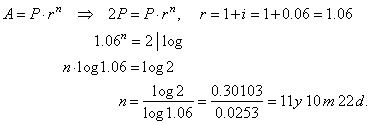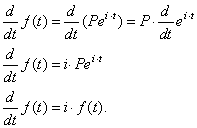|
|
|
| Interest
Calculations |
 Simple interest
Simple interest |
|
Amount of interest,
principal (initial amount), interest rate and amount after n
years |
 Compound interest
Compound interest |
|
Periodic compounding |
|
Continuous compounding |
|
|
|
|
|
|
| Simple interest
|
| An amount of money deposited into a bank for a given period of
time brings to the depositor a profit called interest. |
| The
amount of
interest ( I
) the bank pays you, depends on the
interest rate (
i %
),
the amount of money deposited, denoted as principal P
also called original balance (or
initial investment), and the period of
time n
the money is deposited, |
|
since P
: 1 = I : (i · n)
=> |
 |
|
|
|
|
|
| Simple interest is calculated on
a yearly basis (annually, n
= 1) in which balance grows linearly with
time (as opposed to compound interest). |
| That is, the interest stays
unchanged in each next year of saving because it is always calculated as the percent of the same value, i.e., of the original
principal P, while in the compound interest it is calculated as the
percent of the sum of the balance and the interest from the previous
period. |
|
|
|
If P
is the principal (or initial value of investment) and I
is the interest amount, the accumulated value A
(or final value of
investment) at the end of n
investment periods is given by |
|
A
= P + I = P + i · P · n = P (1 + i n). |
|
|
|
|
|
| Example:
Somebody deposits $20,000 into a savings account
where the rate of interest is 4.8% annually. |
|
How much money in interest will earn after nine months? |
| Solution: |
 |
|
|
| Example:
A bank lends a company money for the six months period at
a rate of 8% annually. |
|
How much was lent if the company should pay $12,000 of interest? |
| Solution: |
 |
|
|
|
| Example:
At what an interest rate was borrowed
$75,000 for one year if
$3,000 to interest is charged? |
| Solution: |
 |
|
|
|
| Example:
For what period of time should be deposited
$200,000 at a 6%
interest rate to earn $6,000 of |
|
interest? |
| Solution: |
 |
|
|
|
| Compound interest |
| In compound interest calculations,
the interest earned in each period is added at the end of a
period to the principal of the previous period, to become the
principal for the next period. |
| The compounding periods can be yearly, semiannually, quarterly,
or the interest can be compounded more frequently even continuously. |
| Thus,
if P
is the principal or initial value of investment and the compound interest
rate is i %,
then |
|
I1 = i P
is the amount of interest earned in the first period. |
| So,
at the end of the first period, the accumulated amount is |
|
A1 = P + I1 = P
+ i P = P(1 + i). |
| Since
the accumulated amount at the end of the first period serve as
the principal amount at the beginning of the second period, then
the amount of interest earned in the second period is |
|
I2 = i A1 = i P(1
+ i) |
| therefore
the accumulated amount at the end of the second period is |
|
A2 = A1 + I2
= P(1 + i) + i P(1 + i) = P(1
+ i)(1 + i) = P(1
+ i)2. |
| Thus,
at the end of n
periods (or after n
years) the accumulated amount or final value of investment is |
|
An
= A = P(1 + i)(1 + i) · · · (1 + i)
= P(1 + i)n |
| or |
An
= A = P · r
n,
where r
= 1 + i |
|
|
|
|
|
| Example:
If $10,000 is invested for
five years at 6% of the interest rate, find the accumulated or
final value and total interest earned at the end of the period
under both, simple and compound interest. |
| Solution:
a)
Under simple interest, |
|
the total interest earned in five years period is |
|
I = i% · P · n =>
I = 6/100
· 10000 · 5 = $3000, |
|
the accumulated value after five years period is |
|
A
= P + I = P (1 + i n) =>
A
= 10000 · (1 + 6/100 · 5) = 10000
· 1.3 = $13000, |
| so
that I
= A -
P
= 13000
-
10000 = $3000. |
|
|
b)
Under compound interest, |
|
the accumulated value after five years period is |
|
A
= P(1 + i%)n =>
A
= 10000 · (1 + 0.06)5
= 10000 · 1.338225 = $13382.25 |
|
therefore, the total interest earned in five years period is |
|
I
= A -
P
= 13382.25
-
10000 =
$3382.25. |
| So,
the interest compounding (or interest earned on interest) brings
the extra $382.25 in
comparison with the simple interest. |
|
| Example:
After how many years will
deposit double at an interest rate of 6%. |
| Solution:
|
 |
|
|
|
 |
|
|
| Example:
At what annual interest
has to be deposited $5,000 for four years to grow to $8,000. |
| Solution:
|
 |
|
|
 |
|
|
|
Periodic compounding |
| Note
that for any given interest rate the investment grows more if
the compounding period is shorter. |
So,
if P is
an amount of money invested for n years at an interest rate
i, compounded
m times per year, then the total number of
compounded periods is mn and the interest rate per period is
i/m
and the accumulated or future value is
|
|
|
|
| Example:
The principal amount of
$2,000 is invested for five years in a compound interest account
paying 6% compounded quarterly, find the final or accumulated
amount in the account. |
| Solution:
|
 |
|
|
| Continuous compounding |
| As for any given interest rate the investment grows more if the compounding period is shorter, we let the number of periods in a year
approach infinity to compound the interest continuously, meaning that the
balance grows by a small amount every instant. |
| Thus,
to derive a formula for continuous compounding we need to
evaluate the above formula when m
tends to infinity (i.e., the year is divided into infinite
number of periods) |
 |
| then
by substituting |
 |
and,
when m ®
oo
then x ®
oo, |
|
|
 |
| that
is, the limit in the square brackets converges to the number e = 2.71828 . . . , the base of natural logarithms,
thus obtained is |
|
|
| the
continuous compounding formula. |
| If
in the above formula we write the final value of balance as
function of time t
(with t
measured in years) |
 |
| and
take its derivative at t, |
 |
| The
result shows that at any instant the balance is changing at a
rate that equals i
times the current balance which correspond to the definition of
continuous compounding. |
|
| Example:
Suppose $5,000 is deposited into an account that pays interest
compounded continuously at an annual rate of 8%. How
much will the account be worth in 20 years? |
| Solution:
|
 |
|
|
|
|
|
|
|
|
|
|
|
| Intermediate
algebra contents |
|
 |
|
| Copyright
© 2004 - 2020, Nabla Ltd. All rights reserved. |